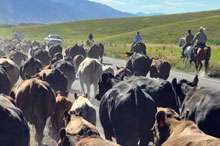No products in the cart.
An Energy of Waste

Biogas Research in Idaho
By Jason Hansen
If you drive through southern Idaho’s Magic Valley around Twin Falls and Jerome, where Idaho’s dairies are concentrated, you might notice the odors that have diminished the quality of life for valley residents. A challenge for the dairy industry has been dealing with its waste, which not only is smelly but increases the potential for contamination of the water table from nitrates in runoff.
Last summer I had the opportunity to participate in a collaborative project between Idaho National Laboratory and the German Biomass Research Center (DBFZ) that might one day help to address this problem. We studied the economic feasibility of producing biogas or biomethane, a natural gas substitute, from Idaho’s dairies.
Since 1980, Idaho has become the third-largest milk producer in the United States, and dairy is the leading agricultural sector in the state. While the number of farms has declined, the size of farms has increased and individual cows have become more productive. What we found out, and published in the scientific journal Applied Energy, was that about forty-five percent of Idaho’s dairy manure could be used to produce biogas and biomethane. The key is farm size. It would take least three thousand cows for a farm to make an anaerobic digestion plant pencil out. Alternatively, the same results could be achieved through joint, cooperative plants and efficient manure transportation.
This content is available for purchase. Please select from available options.
Purchase Only
Purchase Only

